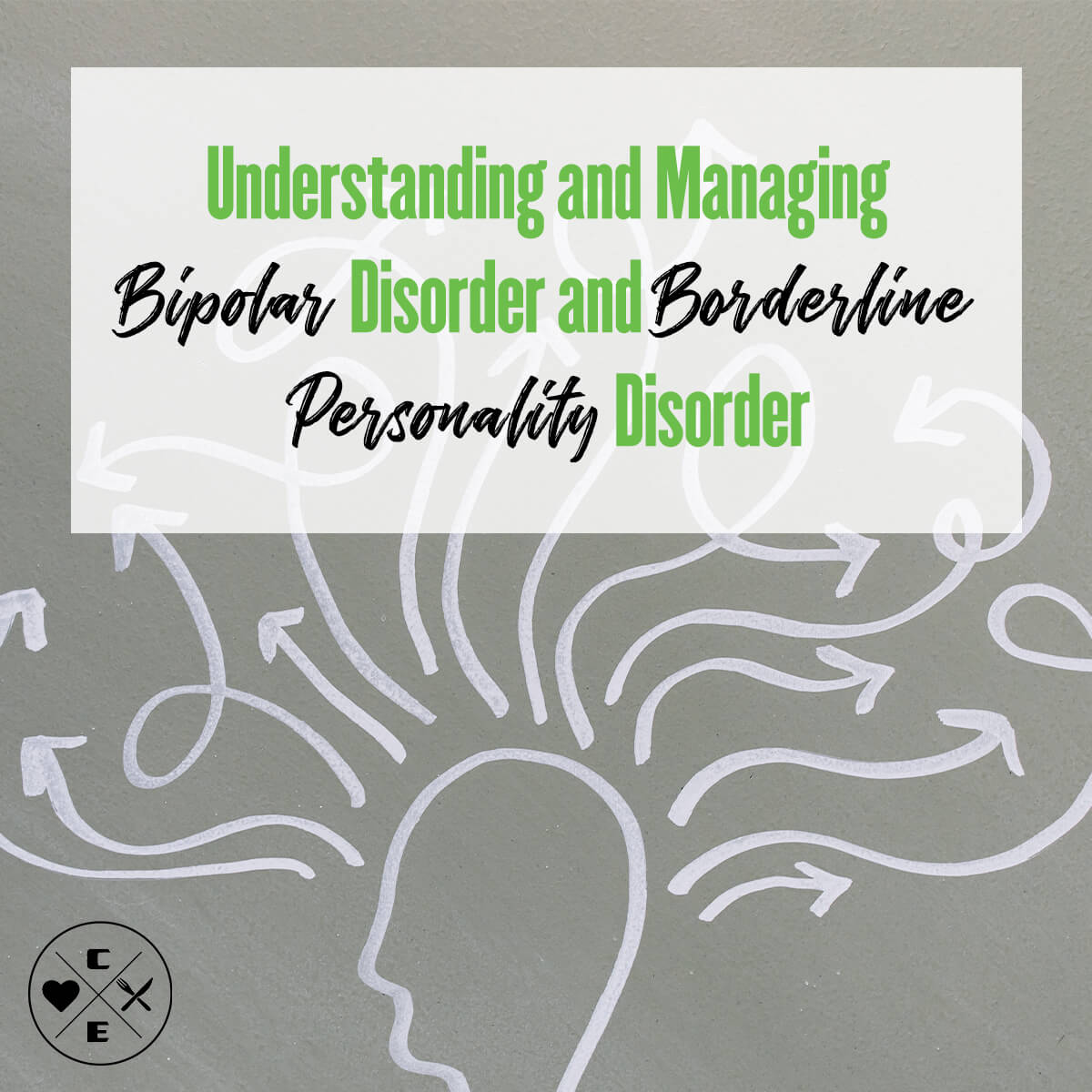
Borderline Personality Disorder VS Bipolar Disorder: A Comprehensive Guide
Jason Nista
Mental Health
13 minute read
Borderline personality disorder vs bipolar are two critical topics in the realm of mental health. Understanding these conditions can be challenging, as they are often misunderstood and misdiagnosed. In this article, we will delve into the similarities and differences between these two disorders and provide practical advice for managing their symptoms. Our goal is to offer a comprehensive, accessible, and engaging resource to enhance your understanding of these conditions and extend support to those grappling with them.
What Is Bipolar Disorder?
Do you feel like your mood changes frequently and drastically? You're not alone. Many people experience shifts in their emotional state, often related to underlying mental health conditions such as bipolar disorder and borderline personality disorder (BPD).
Bipolar disorder is a type of mental health condition that is characterized by extreme changes in mood. Typically, these can range from periods of euphoria or mania—characterized by intense energy and restlessness—to periods of intense sadness or depression. Bipolar disorder can also cause sleep disturbances, difficulty focusing, and difficulty managing everyday tasks.
It’s important to remember that everyone experiences highs and lows differently and while some people with bipolar disorder experience more frequent episodes than others, it is possible to manage the condition with the right treatment plan. With the help of a doctor or mental health professional, you can develop a personalized plan to manage your bipolar symptoms and minimize disruption in your life.
Understanding Bipolar Disorder
To grasp the distinction between borderline personality disorder vs bipolar disorder, let us delve into each one separately. Bipolar disorder, also known as manic-depressive illness, is a mental health condition characterized by extreme fluctuations in mood, energy, and activity levels. These mood swings can range from episodes of intense elation and hyperactivity (mania) to periods of deep sadness and hopelessness (depression). This complex disorder affects millions of people worldwide and can have a significant impact on an individual's daily life, relationships, and overall well-being.
Types of Bipolar Disorder
There are several types of bipolar disorder, each with its own unique pattern of symptoms. The most common forms include:
- Bipolar I Disorder: This type is characterized by at least one manic episode, which may or may not be followed by a depressive episode. A manic episode of Bipolar I Disorder can be severe enough to require hospitalization.
- Bipolar II Disorder: Individuals with Bipolar II Disorder experience at least one depressive episode and one hypomanic episode (a less severe form of mania). Full-blown manic episodes do not occur in this type of bipolar disorder.
- Cyclothymic Disorder (Cyclothymia): This milder form of bipolar disorder involves periods of hypomanic and depressive symptoms lasting for at least two years in adults or one year in children and adolescents. These symptoms do not meet the full criteria for hypomanic or depressive episodes.
Symptoms of Bipolar Disorder
Bipolar disorder, a complex mental health condition, is characterized by distinct mood swings that encompass depressive and manic episodes. Symptoms of bipolar disorder can vary in intensity and duration, but typically include periods of deep sadness, hopelessness, and reduced energy during depressive episodes. These are often countered by:
- Manic episodes: During a manic episode, an individual may experience an elevated mood, increased energy, and a decreased need for sleep. Other symptoms may include racing thoughts, rapid speech, impulsivity, excessive spending, and engagement in risky behaviors. In severe cases, a person may experience psychosis, with delusions or hallucinations.
- Depressive episodes: In a depressive episode, an individual may experience persistent feelings of sadness, hopelessness, and a lack of interest in activities they once enjoyed. Additional symptoms can include changes in appetite, sleep disturbances, fatigue, difficulty concentrating, and thoughts of self-harm or suicide.
- Mixed episodes: Some individuals with bipolar disorder may experience mixed episodes, which involve symptoms of both mania and depression occurring simultaneously or in rapid succession. This can be particularly challenging to manage, as the person may feel agitated and irritable and experience mood swings in a short period.
Causes and Risk Factors
The exact cause of the bipolar disorder is not fully understood, but it is believed to involve a combination of genetic, environmental, and neurobiological factors. Some of the risk factors associated with bipolar disorder include:
- Family history: Individuals with a close relative, such as a parent or sibling, with bipolar disorder, are at a higher risk of developing the condition.
- Age: Bipolar disorder often develops in late adolescence or early adulthood, although it can occur at any age.
- Substance abuse: The use of drugs or alcohol can trigger or exacerbate bipolar symptoms.
- Stressful life events: Major life changes, trauma, or significant loss may contribute to the onset of bipolar disorder in some individuals.
Diagnosis and Misdiagnosis
Diagnosing bipolar disorder can be challenging due to its overlapping symptoms with other mental health conditions, such as major depressive disorder and borderline personality disorder. A thorough evaluation by a mental health professional, including a detailed medical and psychiatric history, is crucial for an accurate diagnosis. Misdiagnosis can lead to inappropriate treatment, potentially worsening the individual's symptoms and delaying recovery.
Understanding Borderline Personality Disorder
Borderline Personality Disorder (BPD) is a complex mental health condition characterized by pervasive instability in mood, interpersonal relationships, self-image, and behavior. Individuals with BPD often experience intense emotional swings and have difficulty managing their emotions, leading to impulsivity and turbulence in various aspects of their lives. The disorder affects a person's ability to function in everyday situations and maintain healthy relationships, impacting their overall well-being and quality of life. It's important to recognize the differences between borderline personality disorder vs bipolar disorder because they require different approaches to treatment and support.
Definition of Borderline Personality Disorder
BPD is a type of personality disorder that falls under the category of Cluster B disorders in the Diagnostic and Statistical Manual of Mental Disorders (DSM-5). Personality disorders are long-standing, maladaptive patterns of behavior and thinking that deviate significantly from cultural norms and expectations, causing distress and impairment in functioning.
Symptoms of Borderline Personality Disorder
Borderline Personality Disorder (BPD) is characterized by a range of distressing symptoms that affect a person's emotions, relationships, and self-image. Individuals with BPD often experience intense mood swings, from extreme sadness and loneliness to intense anger and irritability. Here are the some symptoms:
- Emotional instability: Individuals with BPD often experience intense and unpredictable mood swings that can last from a few hours to several days. These emotional shifts may include periods of extreme sadness, irritability, or anxiety.
- Impulsive behaviors: People with BPD may engage in reckless or impulsive actions, such as substance abuse, binge eating, self-harm, or risky sexual behavior. These behaviors often result from a desire to cope with intense emotions or a fear of abandonment.
- Unstable relationships: Those with BPD tend to have tumultuous relationships marked by extreme idealization and devaluation of others. This pattern, known as "splitting," can lead to intense love followed by sudden disappointment or anger, causing difficulties in maintaining long-term relationships.
- Distorted self-image: Individuals with BPD often have an unstable sense of self and may experience fluctuations in self-esteem, goals, and values. This can lead to feelings of emptiness, identity confusion, and difficulties in making decisions.
Causes and Risk Factors
The exact cause of BPD is not fully understood, but it is believed to involve a combination of genetic, environmental, and neurobiological factors. Some of the risk factors associated with BPD include:
- Family history: Having a close relative, such as a parent or sibling, with BPD or another personality disorder increases the risk of developing BPD.
- Childhood trauma: Experiencing physical, sexual, or emotional abuse, neglect, or separation during childhood may contribute to the development of BPD.
- Brain abnormalities: Research suggests that individuals with BPD may have differences in the structure and function of certain brain regions responsible for emotion regulation, impulsivity, and aggression.
Diagnosis and Misdiagnosis
Diagnosing BPD can be challenging due to its overlapping symptoms with other mental health conditions, such as bipolar disorder, major depressive disorder, and post-traumatic stress disorder. A thorough evaluation by a mental health professional, including a detailed psychiatric history and an assessment of the individual's behavior patterns, is essential for an accurate diagnosis. Misdiagnosis can result in inappropriate treatment, potentially worsening the individual's symptoms and delaying recovery.
Similarities and Differences Between Borderline Personality Disorder VS Bipolar
Borderline personality disorder vs bipolar, although distinct mental health conditions, share certain similarities that can make them difficult to differentiate. However, understanding their key differences is crucial for accurate diagnosis and appropriate treatment.
Overlapping Symptoms
Both bipolar and borderline personality disorder involve mood instability, with individuals experiencing intense emotional highs and lows. In both conditions, these mood swings can impact a person's behavior, relationships, and daily functioning. Additionally, impulsivity, recklessness, and self-harming behaviors can be present in both disorders, further complicating the differentiation between the two.
Key Differences
Despite their overlapping symptoms, there are several fundamental differences between borderline personality disorder vs bipolar:
- Duration and frequency of mood episodes: In bipolar disorder, mood swings typically last for days, weeks, or even months, whereas in borderline personality disorder, emotional shifts can occur within hours or days. BPD mood fluctuations are often more frequent and less predictable than those in bipolar disorder.
- Triggers for mood swings: While mood episodes in bipolar disorder may occur without an identifiable cause, mood swings in borderline personality disorder are often triggered by interpersonal conflicts, perceived rejection, or other emotionally charged events.
- Nature of the conditions: Bipolar disorder is primarily characterized by fluctuations in mood and energy levels, whereas borderline personality disorder involves pervasive patterns of instability in interpersonal relationships, self-image, and emotion regulation.
- Treatment approaches: Treatment for bipolar disorder often involves a combination of medication and psychotherapy, while the primary treatment for borderline personality disorder is psychotherapy, specifically dialectical behavior therapy (DBT) or other specialized therapeutic approaches.
The Role of Emotional Regulation
Emotion regulation plays a significant role in both bipolar disorder and borderline personality disorder. In bipolar disorder, emotion regulation may be impaired due to neurobiological factors contributing to the extreme mood swings experienced by individuals with the condition. In BPD, emotion regulation difficulties are a core feature of the disorder, leading to rapid and intense emotional shifts, impulsivity, and interpersonal difficulties.
Misconceptions and Stigma
Both bipolar disorder and borderline personality disorder are often misunderstood and stigmatized, which can have a significant impact on the individuals living with these conditions. Common misconceptions include the belief that individuals with bipolar disorder are "crazy" or dangerous or that those with BPD are manipulative and attention-seeking. These stigmas can create barriers to seeking help, contribute to feelings of isolation, and hinder recovery. Educating oneself and others about these conditions is essential to reduce stigma and promote understanding and support for those affected.
Living with Bipolar Disorder or Borderline Personality Disorder
Living with bipolar disorder or borderline personality disorder can be incredibly challenging, and it's important to remember that it's okay to feel overwhelmed at times. However, it's crucial to understand that with appropriate treatment and support, individuals can manage their symptoms and lead fulfilling lives. It's essential to offer comforting words for someone with anxiety and let them know that they are not alone in their journey. Here are some practical strategies for coping with these conditions, as well as advice for family and friends on how to offer support. Remember, showing empathy, patience, and providing comforting words can make a significant difference in someone's life as they navigate these mental health challenges.
Managing Symptoms in Daily Life
- Stick to a routine: Maintaining a consistent daily routine can help regulate mood swings and reduce stress. Prioritize regular sleep, meals, and exercise schedules.
- Seek professional help: Engaging in therapy, such as cognitive-behavioral therapy (CBT) or dialectical behavior therapy (DBT), can be invaluable in managing symptoms and developing healthy coping strategies.
- Take medications as prescribed: If medication is part of your treatment plan, adhere to the prescribed regimen and consult your healthcare provider about any concerns or side effects.
- Practice self-care: Engage in activities that promote relaxation, stress reduction, and overall well-being, such as meditation, yoga, or hobbies that bring joy.
- Monitor your symptoms: Keep track of your mood, energy levels, and potential triggers to better understand patterns and communicate more effectively with healthcare providers.
Building and Maintaining Healthy Relationships
- Set boundaries: Establish clear and consistent boundaries with others to maintain a sense of emotional safety and stability in your relationships.
- Communicate openly: Be honest about your feelings, needs, and challenges with those close to you, fostering understanding and mutual support.
- Seek therapy for relationship issues: Couples or family therapy can help address conflicts and improve communication skills, leading to stronger relationships.
- Build a support network: Cultivate connections with supportive friends, family members, or support groups to share experiences and seek encouragement.
Workplace Considerations
- Identify accommodations: Know your rights under the Americans with Disabilities Act (ADA) and discuss potential accommodations with your employer, such as flexible work hours or remote work options.
- Manage stress: Develop strategies to cope with workplace stress, like taking breaks, delegating tasks, and maintaining a healthy work-life balance.
- Disclose your condition cautiously: Consider the potential benefits and drawbacks of disclosing your condition to your employer or coworkers, and choose a disclosure strategy that feels comfortable and safe.
Tips For Family and Friends
- Educate yourself: Learn about bipolar disorder or borderline personality disorder to better understand the challenges your loved one faces and to offer appropriate support.
- Be patient and empathetic: Show compassion and understanding for your loved one's emotional struggles and validate their feelings.
- Encourage treatment: Encourage your loved one to seek professional help and offer assistance in finding appropriate resources.
- Establish boundaries: Set limits to protect your own mental health and well-being while supporting your loved one.
Final Thoughts
In conclusion, navigating the complexities of borderline personality disorder vs bipolar disorder can be a daunting task, but it is essential for accurate diagnosis and effective treatment. These two mental health conditions share some overlapping symptoms, but they also exhibit fundamental differences in terms of duration, triggers, and nature.
It is crucial to remember that both individuals with bipolar disorder and those with borderline personality disorder face unique challenges, and misconceptions and stigma surrounding these conditions can add to their difficulties. Education and understanding are key to reducing stigma and providing much-needed support to those affected.
FAQ
What are the common symptoms of Bipolar Disorder and BPD?
Common symptoms of Bipolar Disorder include mood swings, impulsivity, high energy during manic phases, and low energy during depressive phases. BPD symptoms encompass unstable self-identity, intense fear of abandonment, mood swings, and impulsive behaviors.
Are there any genetic factors associated with Bipolar Disorder and BPD?
Yes, there is evidence of a genetic predisposition to both disorders. If you have a family history of either condition, you may be at a higher risk.
Can Bipolar Disorder and BPD be cured?
These disorders are generally not curable, but their symptoms can be managed effectively with proper treatment and support. Many individuals lead fulfilling lives with appropriate care.
Can someone have both Bipolar Disorder and BPD simultaneously?
Yes, comorbidity (having both disorders) is possible. This can make diagnosis and treatment more challenging, but it's essential to address both conditions individually for the best outcome.
What should I do in a crisis situation involving someone with Bipolar Disorder or BPD?
In an emergency, contact a mental health crisis hotline, a healthcare professional, or take them to the nearest emergency room. Safety should always be the top priority.



